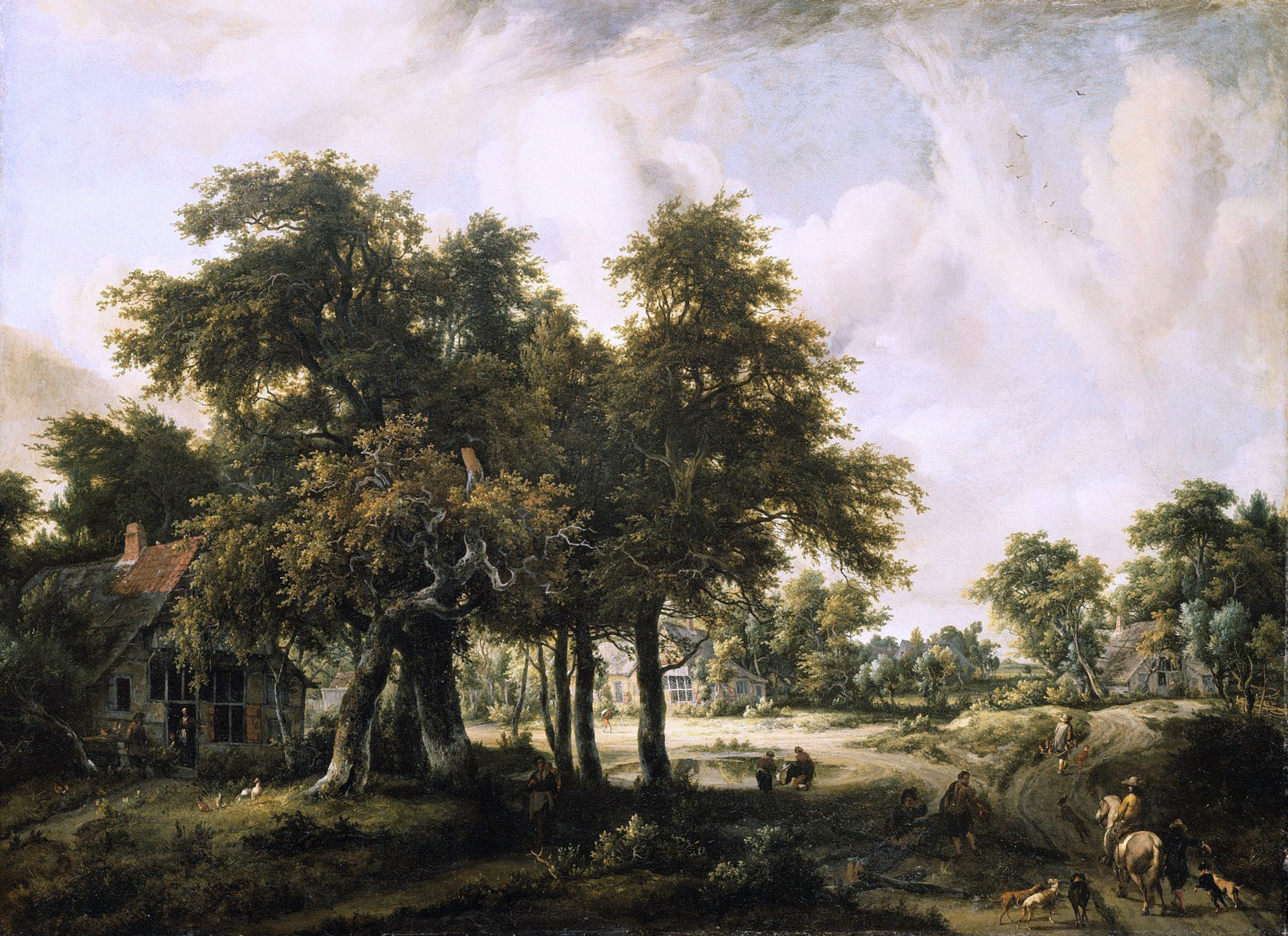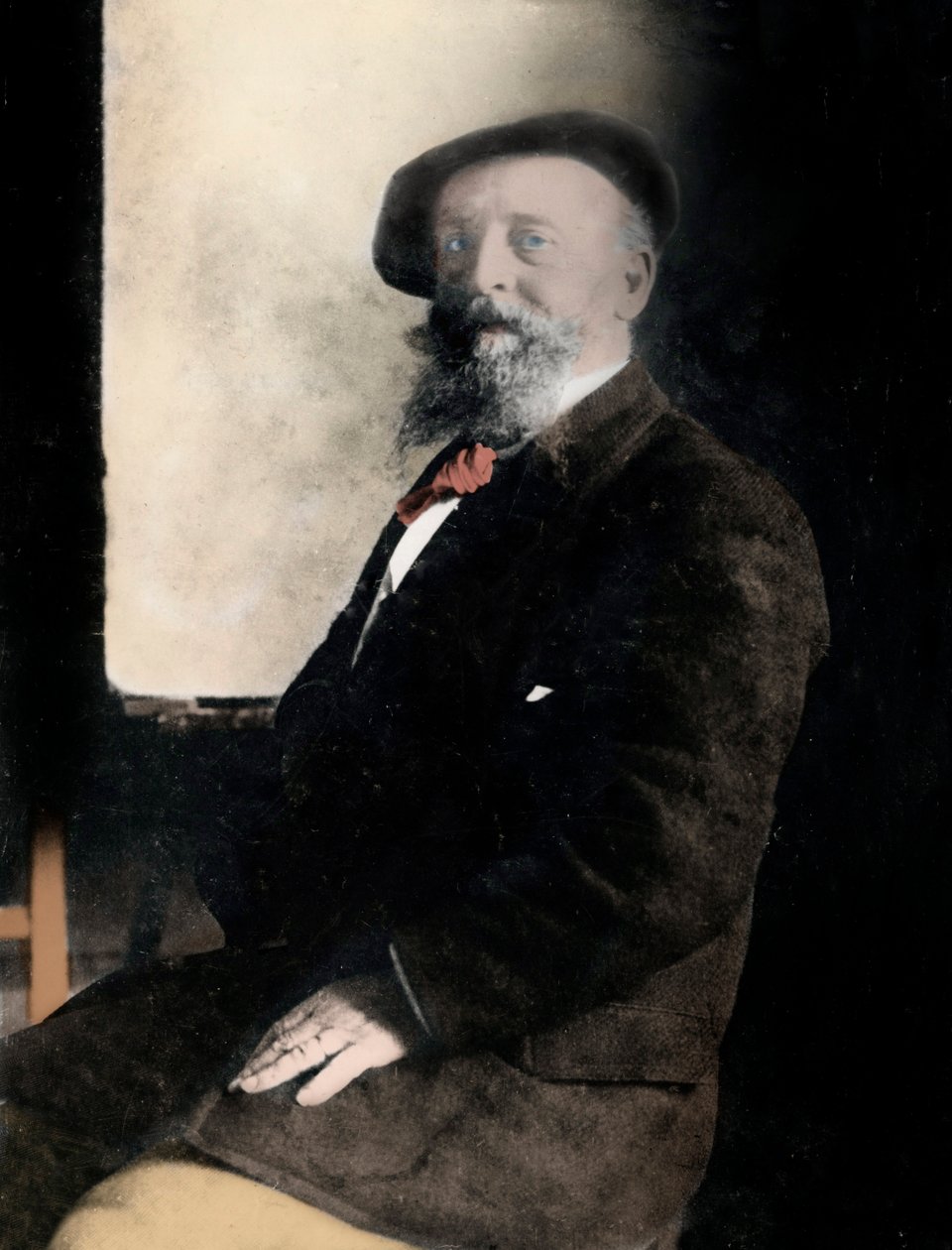|
Chemin De La Machine, Louveciennes
''Chemin de la Machine, Louveciennes'' (alternatively titled ''Route de Sèvres near Louveciennes'') is an 1873 painting by Alfred Sisley. Exhibited at the Exposition Universelle (1900), Exposition Universelle of 1900, it entered the Louvre in 1918 from the collection of Joanny Peytel, and has been in the Musée d'Orsay since 1986. Description It is an oil on canvas that measures 54 × 73 cm, a large size. The clarity of the sky which accentuates the impression of cold contrasts with the brown tones of the ground which are reinforced by the oblique light. The road running perpendicular to the surface of the painting gives the illusion of a three-dimensional representation. The impression of depth is reinforced by the row of trees, punctuating the trunks and their shadows with vertical and horizontal lines. The rise creates an off-center vanishing point, towards a bird's eye view of the sunny background. Like Johan Barthold Jongkind, Sisley humanizes the landscape, introd ... [...More Info...] [...Related Items...] OR: [Wikipedia] [Google] [Baidu] |
Alfred Sisley
Alfred Sisley (; ; 30 October 1839 – 29 January 1899) was an Impressionist landscape painter who was born and spent most of his life in France, but retained British citizenship. He was the most consistent of the Impressionists in his dedication to painting landscape ''en plein air'' (i.e., outdoors). He deviated into figure painting only rarely and, unlike Renoir and Pissarro, he found that Impressionism fulfilled his artistic needs. Among his important works are a series of paintings of the River Thames, mostly around Hampton Court, executed in 1874, and landscapes depicting places in or near Moret-sur-Loing. The notable paintings of the Seine and its bridges in the former suburbs of Paris are like many of his landscapes, characterised by tranquillity, in pale shades of green, pink, purple, dusty blue and cream. Over the years Sisley's power of expression and colour intensity increased. Richard Shone: ''Sisley.'' London: Phaidon Press 1999. Biography Sisley was born in Par ... [...More Info...] [...Related Items...] OR: [Wikipedia] [Google] [Baidu] |
Exposition Universelle (1900)
The Exposition Universelle of 1900, better known in English as the 1900 Paris Exposition, was a world's fair held in Paris, France, from 14 April to 12 November 1900, to celebrate the achievements of the past century and to accelerate development into the next. It was held at the esplanade of Les Invalides, the Champ de Mars, the Trocadéro and at the banks of the Seine between them, with an additional section in the Bois de Vincennes, and it was visited by more than 50 million people. Many international congresses and other events were held within the framework of the Exposition, including the 1900 Summer Olympics. Many technological innovations were displayed at the Fair, including the ''Grande Roue de Paris'' ferris wheel, the '' Rue de l'Avenir'' moving sidewalk, the first ever regular passenger trolleybus line, escalators, diesel engines, electric cars, dry cell batteries, electric fire engines, talking films, the telegraphone (the first magnetic audio recorder), the ... [...More Info...] [...Related Items...] OR: [Wikipedia] [Google] [Baidu] |
Musée D'Orsay
The Musée d'Orsay ( , , ) ( en, Orsay Museum) is a museum in Paris, France, on the Left Bank of the Seine. It is housed in the former Gare d'Orsay, a Beaux-Arts railway station built between 1898 and 1900. The museum holds mainly French art dating from 1848 to 1914, including paintings, sculptures, furniture, and photography. It houses the largest collection of Impressionist and post-Impressionist masterpieces in the world, by painters including Berthe Morisot, Claude Monet, Édouard Manet, Degas, Renoir, Cézanne, Seurat, Sisley, Gauguin, and van Gogh. Many of these works were held at the Galerie nationale du Jeu de Paume prior to the museum's opening in 1986. It is one of the largest art museums in Europe. In 2021 the museum had one million visitors, up 30 percent from attendance in 2020, but far behind earlier years due to the COVID-19 pandemic. Despite the drop, it ranked fifteenth in the list of most-visited art museums in 2020. History The museum building was or ... [...More Info...] [...Related Items...] OR: [Wikipedia] [Google] [Baidu] |
Meindert Hobbema
Meindert Lubbertszoon Hobbema (bapt. 31 October 1638 – 7 December 1709) was a Dutch Golden Age painter of landscapes, specializing in views of woodland, although his most famous painting, ''The Avenue at Middelharnis'' (1689, National Gallery, London), shows a different type of scene. Hobbema was a pupil of Jacob van Ruisdael, the pre-eminent landscape painter of the Dutch Golden Age, and in his mature period produced paintings developing one aspect of his master's more varied output, specializing in "sunny forest scenes opened by roads and glistening ponds, fairly flat landscapes with scattered tree groups, and water mills", including over 30 of the last in paintings. The majority of his mature works come from the 1660s; after he married and took a job as an exciseman in 1668 he painted less, and after 1689 apparently not at all. He was not very well known in his lifetime or for nearly a century after his death, but became steadily more popular from the last decades of t ... [...More Info...] [...Related Items...] OR: [Wikipedia] [Google] [Baidu] |
The Avenue At Middelharnis
''The Avenue at Middelharnis'' is a Dutch Golden Age painting of 1689 by Meindert Hobbema, now in the National Gallery, London. It is in oil on canvas and measures . It shows a road leading to the village of Middelharnis on the island of Goeree-Overflakkee in the Meuse ( nl, Maas) delta in South Holland, the Netherlands. The painting has long been one of the best-known Dutch landscape paintings, and certainly Hobbema's best-known work, at least in the English-speaking world: "it is as if the artist had produced only a single picture" according to Christopher Lloyd. Cornelis Hofstede de Groot, the great specialist of a century ago, thought it "the finest picture, next to Rembrandt's '' Syndics'', which has been painted in Holland". According to Michael Levey, "it occupies a position in painting somewhat equivalent to that in poetry of '' Gray's Elegy'', and for Seymour Slive "it is the swan song of Holland's great period of landscape painting which fully deserves its ... [...More Info...] [...Related Items...] OR: [Wikipedia] [Google] [Baidu] |
Jean-Baptiste Camille Corot
Jean-Baptiste-Camille Corot ( , , ; July 16, 1796 – February 22, 1875), or simply Camille Corot, is a French landscape and portrait painter as well as a printmaker in etching. He is a pivotal figure in landscape painting and his vast output simultaneously referenced the Neo-Classical tradition and anticipated the plein-air innovations of Impressionism. Biography Early life and training Jean-Baptiste-Camille Corot was born in Paris on July 16, 1796, in a house at 125 Rue du Bac, now demolished. His family were bourgeois people—his father was a wig maker and his mother, Marie-Françoise Corot, a milliner—and unlike the experience of some of his artistic colleagues, throughout his life he never felt the want of money, as his parents made good investments and ran their businesses well. After his parents married, they bought the millinery shop where his mother had worked and his father gave up his career as a wigmaker to run the business side of the shop. The store wa ... [...More Info...] [...Related Items...] OR: [Wikipedia] [Google] [Baidu] |
Salomon Van Ruysdael
Salomon van Ruysdael (c. 1602, Naarden – buried 3 November 1670, Haarlem) was a Dutch Golden Age landscape painter. He was the uncle of Jacob van Ruisdael.Salomon van Ruysdael in the Biography According to he was the son of a woodworker who specialized in making fancy frames for mirrors and paintings.[...More Info...] [...Related Items...] OR: [Wikipedia] [Google] [Baidu] |
List Of Paintings By Alfred Sisley
This is an incomplete list of the paintings by the British Impressionist artist Alfred Sisley, who was born to British parents in France, where he subsequently spent the majority of his life. ;Timeline * 1839 Born in Paris * 1839–1870 Paris * 1870–1875 Louveciennes, Yvelines (visit to England, 1874) * 1875–1877 Marly-le-Roi, Yvelines * 1877–1880 Sèvres, Hauts-de-Seine * 1880–1882 Veneux-les-Sablons, Seine-et-Marne * 1882–1899 Moret-sur-Loing, Seine-et-Marne (visit to Wales, 1897) * 1899 Died in Moret-sur-Loing 1860s 1870s 1880s 1890s References {{Lists of paintings Lists of paintings, Sisley, Alfred Paintings by Alfred Sisley, ... [...More Info...] [...Related Items...] OR: [Wikipedia] [Google] [Baidu] |
Paintings By Alfred Sisley
Painting is the practice of applying paint, pigment, color or other medium to a solid surface (called the "matrix" or "support"). The medium is commonly applied to the base with a brush, but other implements, such as knives, sponges, and airbrushes, can be used. In art, the term ''painting ''describes both the act and the result of the action (the final work is called "a painting"). The support for paintings includes such surfaces as walls, paper, canvas, wood, glass, lacquer, pottery, leaf, copper and concrete, and the painting may incorporate multiple other materials, including sand, clay, paper, plaster, gold leaf, and even whole objects. Painting is an important form in the visual arts, bringing in elements such as drawing, composition, gesture (as in gestural painting), narration (as in narrative art), and abstraction (as in abstract art). Paintings can be naturalistic and representational (as in still life and landscape painting), photographic, abstract, narrative, ... [...More Info...] [...Related Items...] OR: [Wikipedia] [Google] [Baidu] |
1873 Paintings
Events January–March * January 1 ** Japan adopts the Gregorian calendar. ** The California Penal Code goes into effect. * January 17 – American Indian Wars: Modoc War: First Battle of the Stronghold – Modoc Indians defeat the United States Army. * February 11 – The Spanish Cortes deposes King Amadeus I, and proclaims the First Spanish Republic. * February 12 ** Emilio Castelar, the former foreign minister, becomes prime minister of the new Spanish Republic. ** The Coinage Act of 1873 in the United States is signed into law by President Ulysses S. Grant; coming into effect on April 1, it ends bimetallism in the U.S., and places the country on the gold standard. * February 20 ** The University of California opens its first medical school in San Francisco. ** British naval officer John Moresby discovers the site of Port Moresby, and claims the land for Britain. * March 3 – Censorship: The United States Congress enacts the Comstock Law, makin ... [...More Info...] [...Related Items...] OR: [Wikipedia] [Google] [Baidu] |







